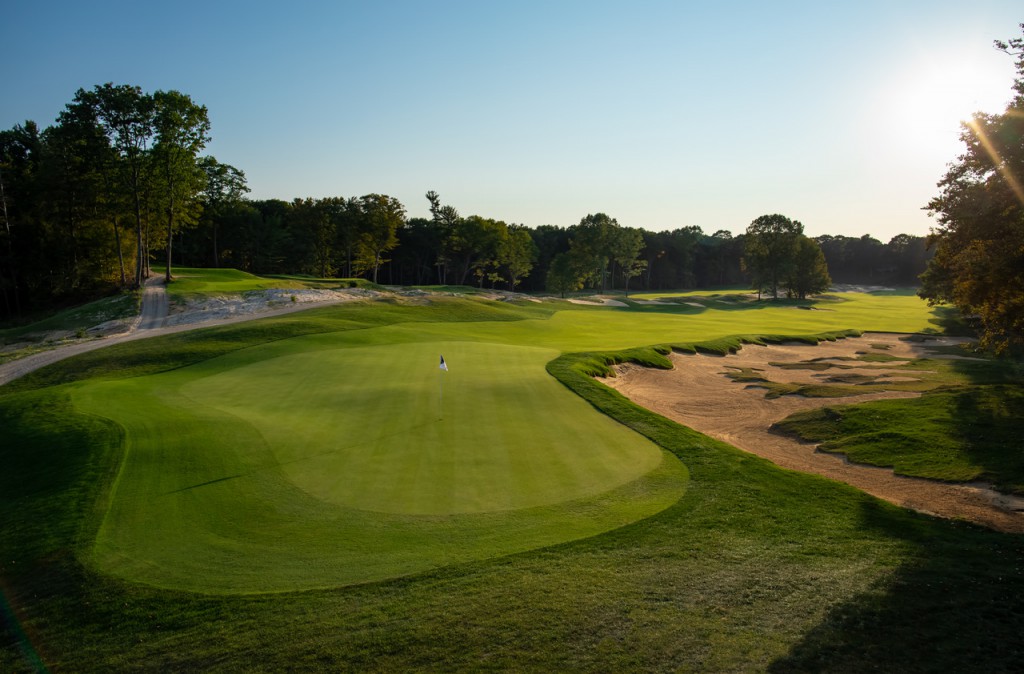(Grand Haven, MI) There are two main stories at American Dunes Golf Club in Grand Haven. There’s the destination golf course designed by Jack Nicklaus and there’s the purpose behind the entire project envisioned by Lt. Colonel and PGA golf professional Dan Rooney. The magic of the place is how expertly these two stories are interwoven to become a compelling, and to some, emotional experience.
Rarely has a golf course been so elevated and employed to help tell of a cause that was once sorely overlooked.
Unless you’ve been living in a cave, you know American Dunes was, in Rooney’s words, a total “re-imagination” of the former Grand Haven Golf Club by Nicklaus. Over 2500 trees were removed, opening up the tree-lined fairways to wide corridors. Fitting to its name, native dunes and waste areas were exposed and huge bunkers were added. Golfers who once played Grand Haven will be duly impressed if not amazed by the transformation. Even cynical naysayers will give a complimentary nod to Nicklaus and his team for delivering an appropriate “wow factor.”
Moreover, the course is walkable (I’ve done it twice under four hours) and is largely player friendly in terms of open front green sites, putt-able green surrounds and wide fairways. And the ponds are placed as lateral penalty areas. Only on the par-threes and a few par-fours are the deep yawning bunkers directly in front of the your shot. A good sand game will be necessary if shots are errant.
As an aside, it’s somewhat ironic how the trend in golf architecture has swung back to its early roots of links design. Jerry Matthews, a prolific Michigan Hall of Fame designer, once remarked to me that parkland courses were in vogue when he was starting out in business with his father Bruce in the 1960s. “Golfers thought the most beautiful courses were ones with tree-lined fairways,” said Matthews. And that was the central appeal of Grand Haven GC, which quickly ascended to Golf Digest’s “50 Best Public Courses” list. But nowadays, a links look and feel are back on top.
Originally, the course routing at American Dunes would have followed the general path of the old Grand Haven. In fact, those opening holes were designed to produce a surprise vista and “aha moment” when players reached their second shots on the original second (now 11th) hole. But Rooney and others realized logistics and traffic flow were better served by reversing the nines.
True to a Nicklaus Signature Design, the conditions at American Dunes are exemplary for such a new course. In particular, the greens are top notch, imparting true and, when allowed, fast surfaces. General Manager Doug Bell said the green speed “will stimp around 10-10 1/2 on a regular basis.” Anything slower would be a shame for golfers paying for such a high profile and championship calibre experience.
Friends have asked me what course American Dunes reminds me of. In Michigan, it would be Forest Dunes in Roscommon for its general layout and feel, waste areas and bunkering. Although it doesn’t have its enormous space and secluded locale, Pine Valley in New Jersey comes to mind, as well. Good company, eh?
The purpose of the course is to help celebrate and venerate those fallen military personnel in keeping with the Folds of Honor Foundation founded in 2007 at Grand Haven by Rooney to assist active military and their families with educational scholarships. At each hole there is a plaque dedicated to a fallen military member along with one commemorating one of Nicklaus’s 18 major championships.
Behind the 17th green there’s a white cross where golfers are asked to toss the nickel coin they were given by the starter on the first tee. The nickel represents a long tradition at gravesites of fighter pilots as in “throw a nickel on the grass, save a fighter pilot’s ass.”
Adding to the patriotic theme of the course is the tradition of “Taps” being played each day at 1300 hours (or 1 pm) and a bell chiming 13 times. Thirteen is symbolic of the 13 folds required to make the triangle shape of the flag given to the family of fallen soldiers. Blue yardage markers in the center of the fairways are also in that triangular design. Other patriotic touches include the red, white and blue golf carts (with speakers), five sets of tees with different markers, and of course, the gigantic American flag that flies high near the ninth and 10th fairways.
The entrance to the grounds and the clubhouse is also thoughtfully considered to further the story of the Folds of Honor. An 8-foot tall concrete wall surrounds, guides and educates visitors as they make their way to the pro shop. What’s there is best left unsaid but suffice to say, it sets a theme for the day.
The clubhouse is adorned with terrific photos of Nicklaus, Rooney and his fellow jet fighter aviators. Sure to be a hit will be the “Squadron Bar” with hanging miniature replicas of F-16 jets.
Set to open next year will be The Camp at American Dunes, providing on-site accommodations and 16 rooms for members and guests. Such an amenity will help the course draw “big game hunters” from around the country.
On Sunday, Rooney reported over 11,000 rounds have been booked already for the course. With greens fees at $150 and with discounts for veterans and active military personnel, this year and next should be very busy for American Dunes. Its long term success will depend on how successful the course attracts the Chicago and Indianapolis markets in addition to Detroit and Ohio.
But one thing is certain: the Pure Michigan campaign has another winning destination to celebrate.


